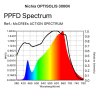If you're referring to the latest OSCONIQ S 3030 0.2W white phosphors, on paper they look really good – even slightly better than Nichia. I say that with two caveats:
1. Nichia has just released its latest 3030 model NF2W757HT-F1. Again, on paper, it is a little bit more efficient than the NF2W757GT-V3F1 that we use and looks better than Osram's OSONIQ (which came out about a year after we chose the V3F1).
2. There is no such thing as "top bins".
That second point may surprise a few people, but the reality is when LED manufacturers advertise "top bins", the figures are mostly bragging rights because you can almost never buy the top flux/lowest voltage bins on the data-sheets. And much of the time the top flux bins are grouped with lower bins to ensure supply (Osram does this).
The reason is because the top flux bins may represent just 5% or less of total production. And within this 5%, almost none will be at the top end of the "top bin" advertised on the spec sheet. That is why LED manufacturers provide "typical" flux and voltage ratings on their data sheets to give buyers a realistic picture of what they will be buying.
For example, the 2700K Nichia CRI90 LEDs we buy come in P10d22 flux bins and K22 voltage bins. There is a K21 Vf bin, but there is no such thing as a K21 Vf/P11 Flux bin outside Nichia's lab.
There
are K22/P11 bins. But you can't buy these in any quantity (because Nichia has to find buyers for the 95-98 out of 100 LEDs that you don't buy). And even if you could buy them in quantity, the "top bin" P11 ranges from 30.3-36.0 lumens per watt on the datasheet, but that doesn't mean you will get mostly 36.0lpw LEDs! That's just the highest the company has been able to achieve in that bin and you might – just might – get a few of them in a 5,000 reel of LEDs.
The P10d22 bins we get represent the minimum flux bins – which range from the upper cut of P10 (d22) to P11. So technically this is the "top bin" for production. The last time we purchased these LEDs, we bought 95% of Nichia's stock. That gives you some idea of how rare the "top bin" P11 is in that particular LED.
There is also the fact that some LED manufacturers are not honest about their performance claims. I have a test report here showing "top bin" Samsung LM301B LEDs performing 4% lower than advertised. Perhaps that was an anomaly. Or perhaps it was indicative of a wider trend.









